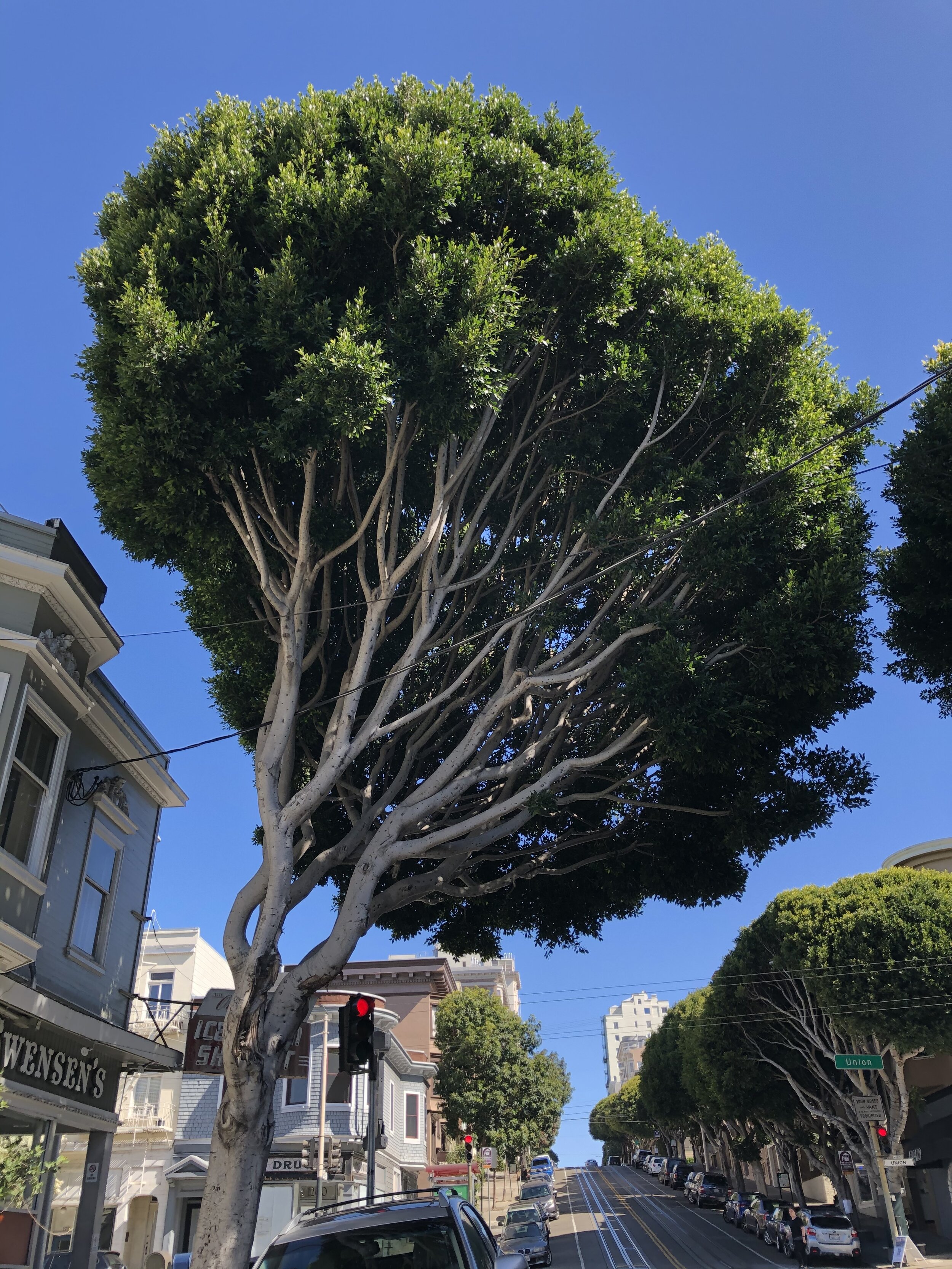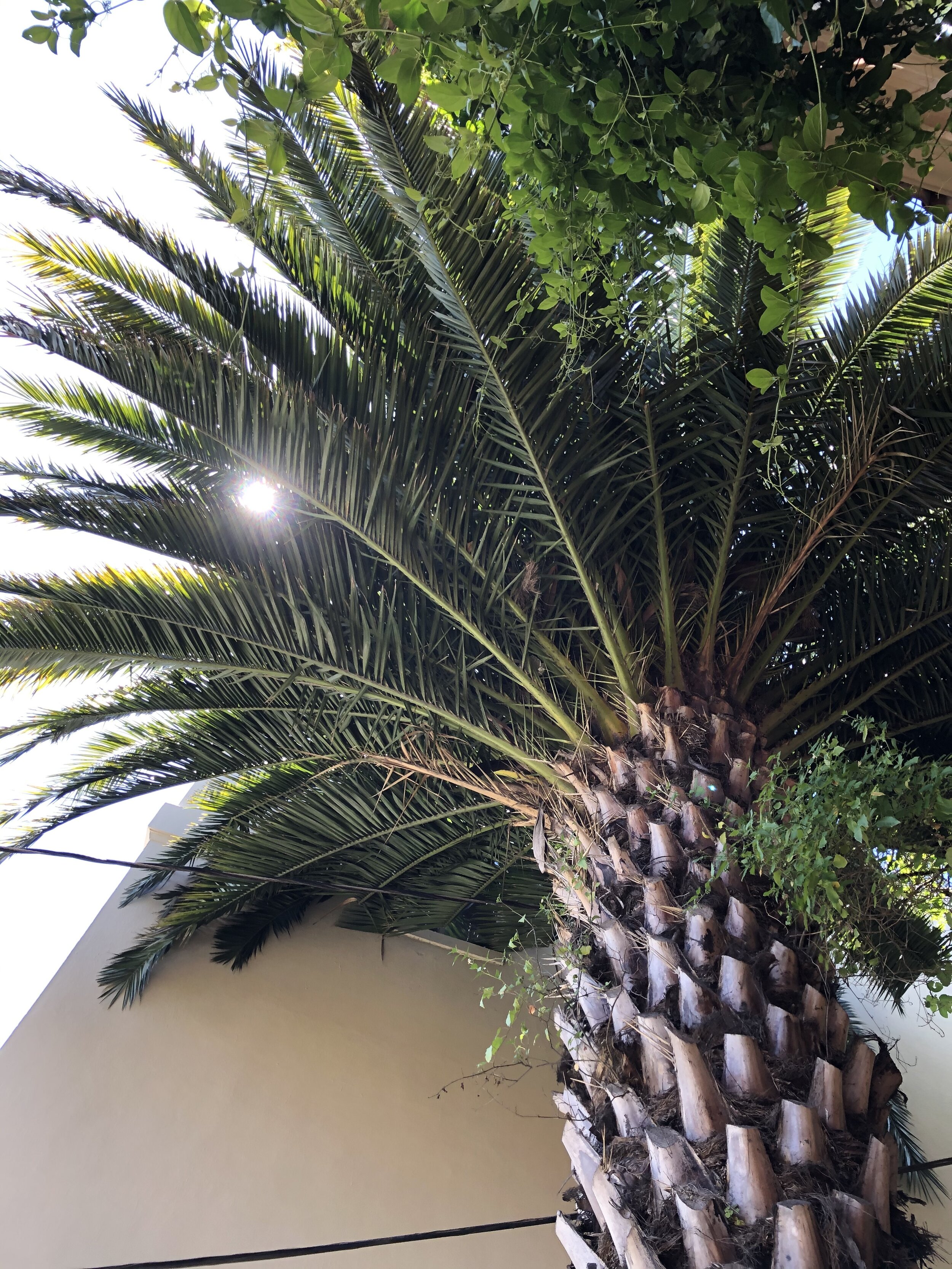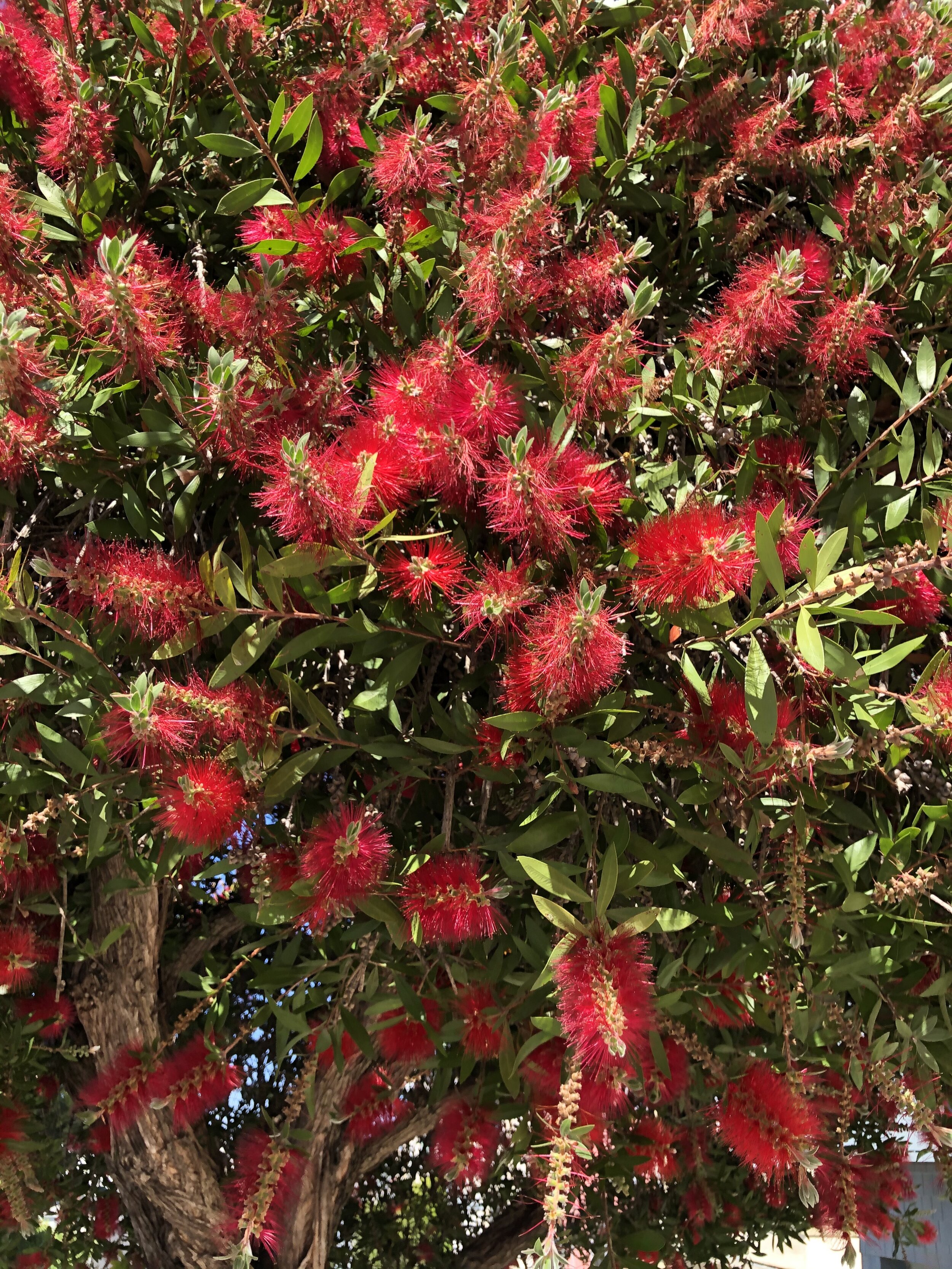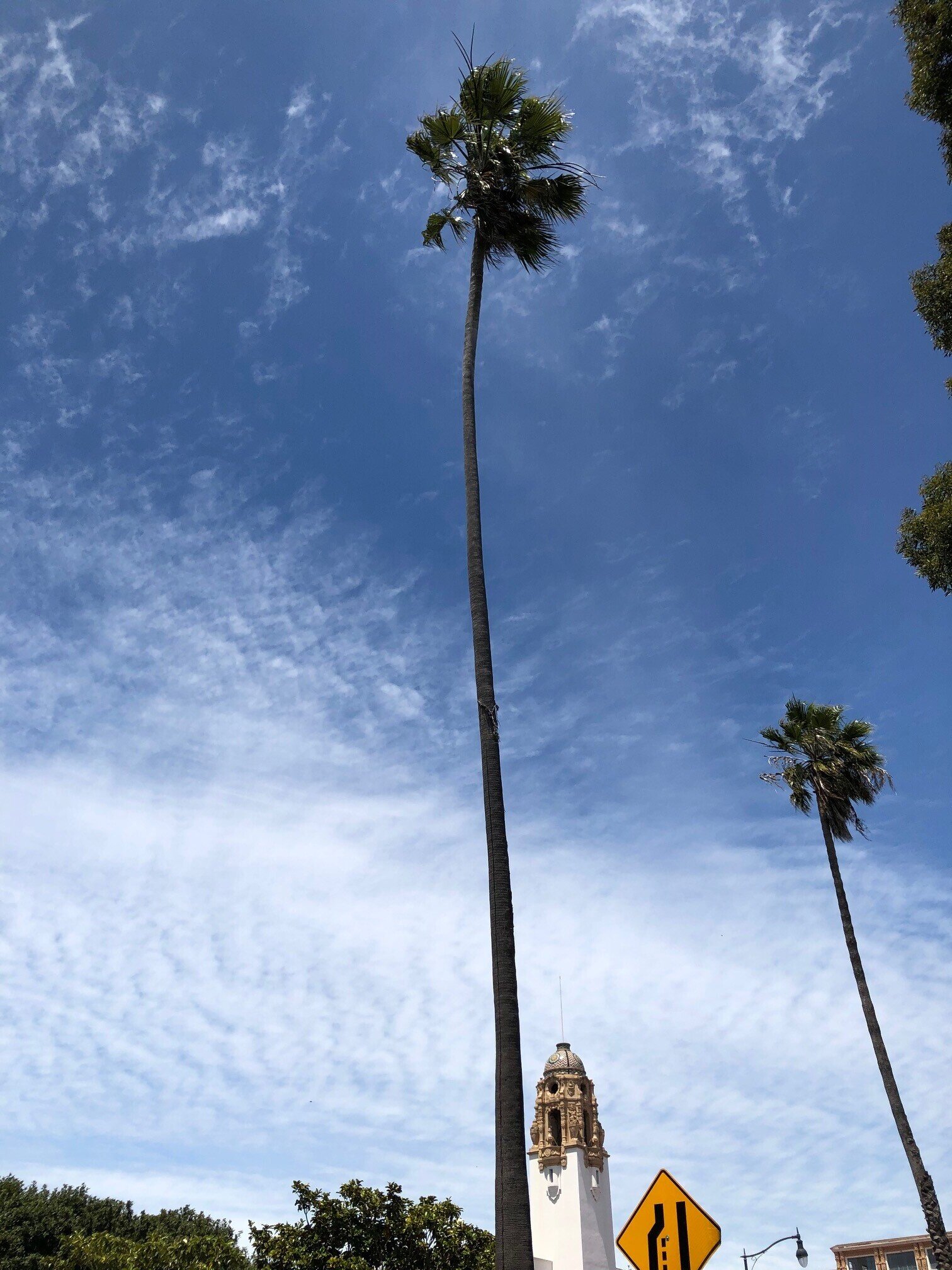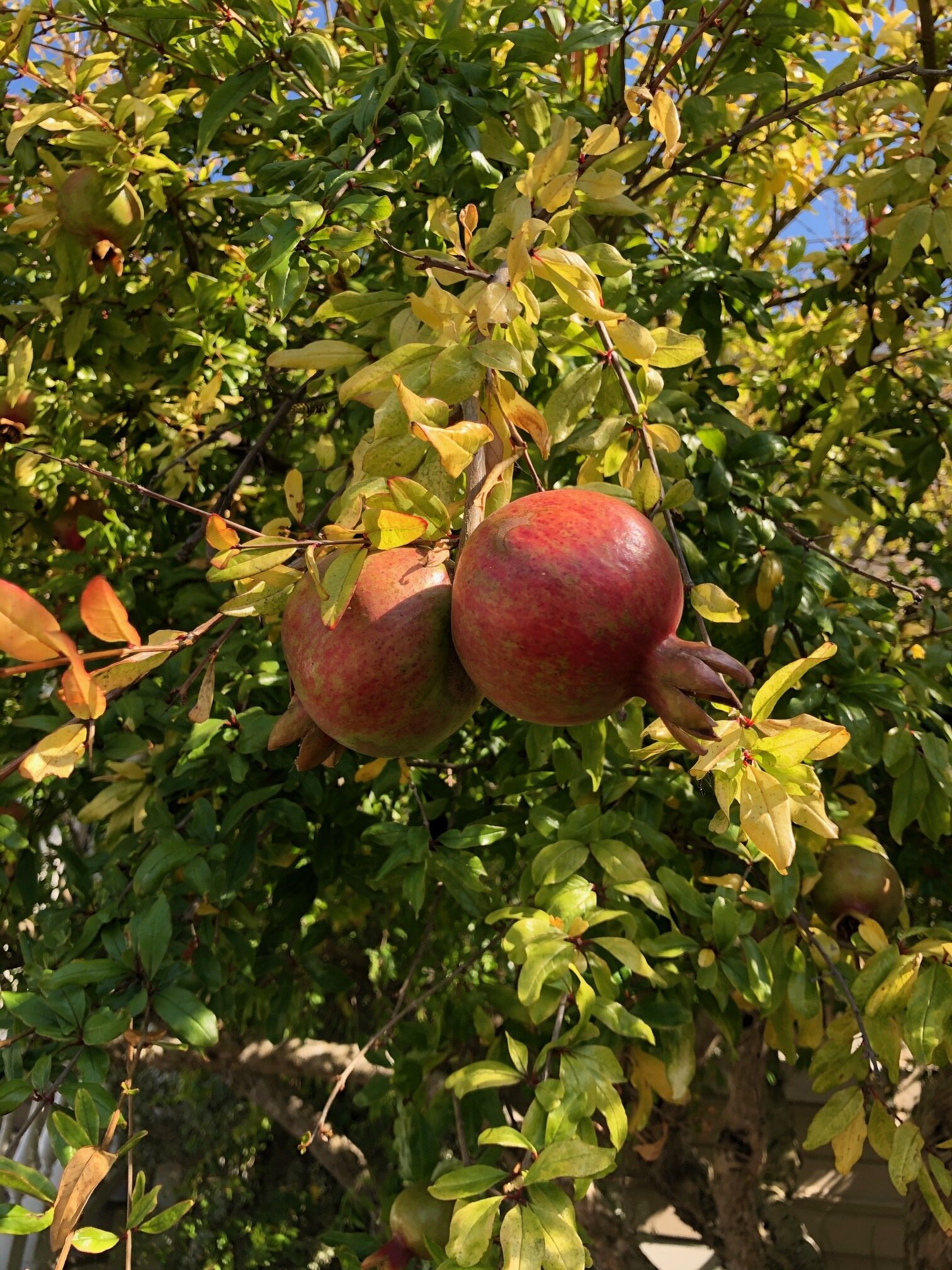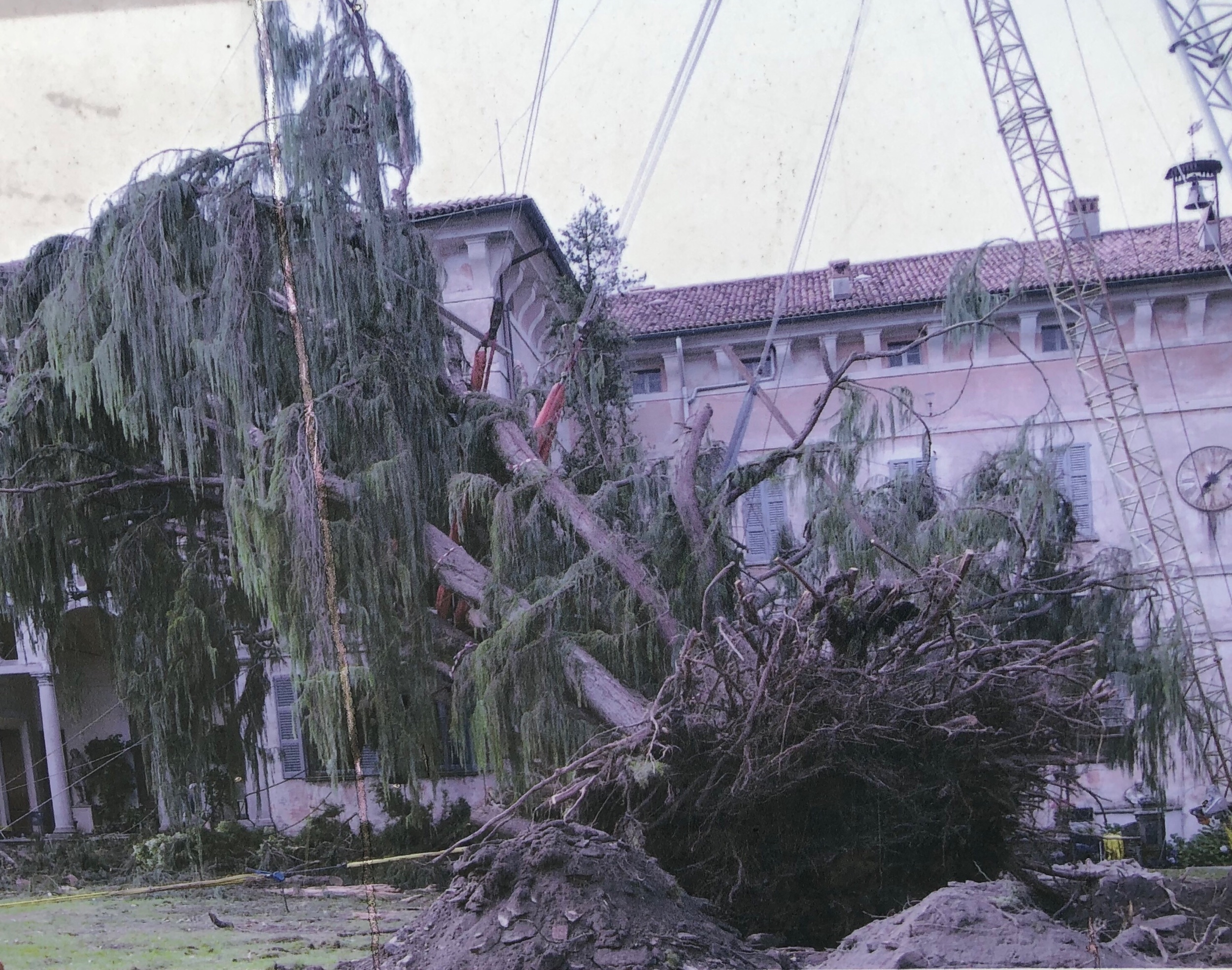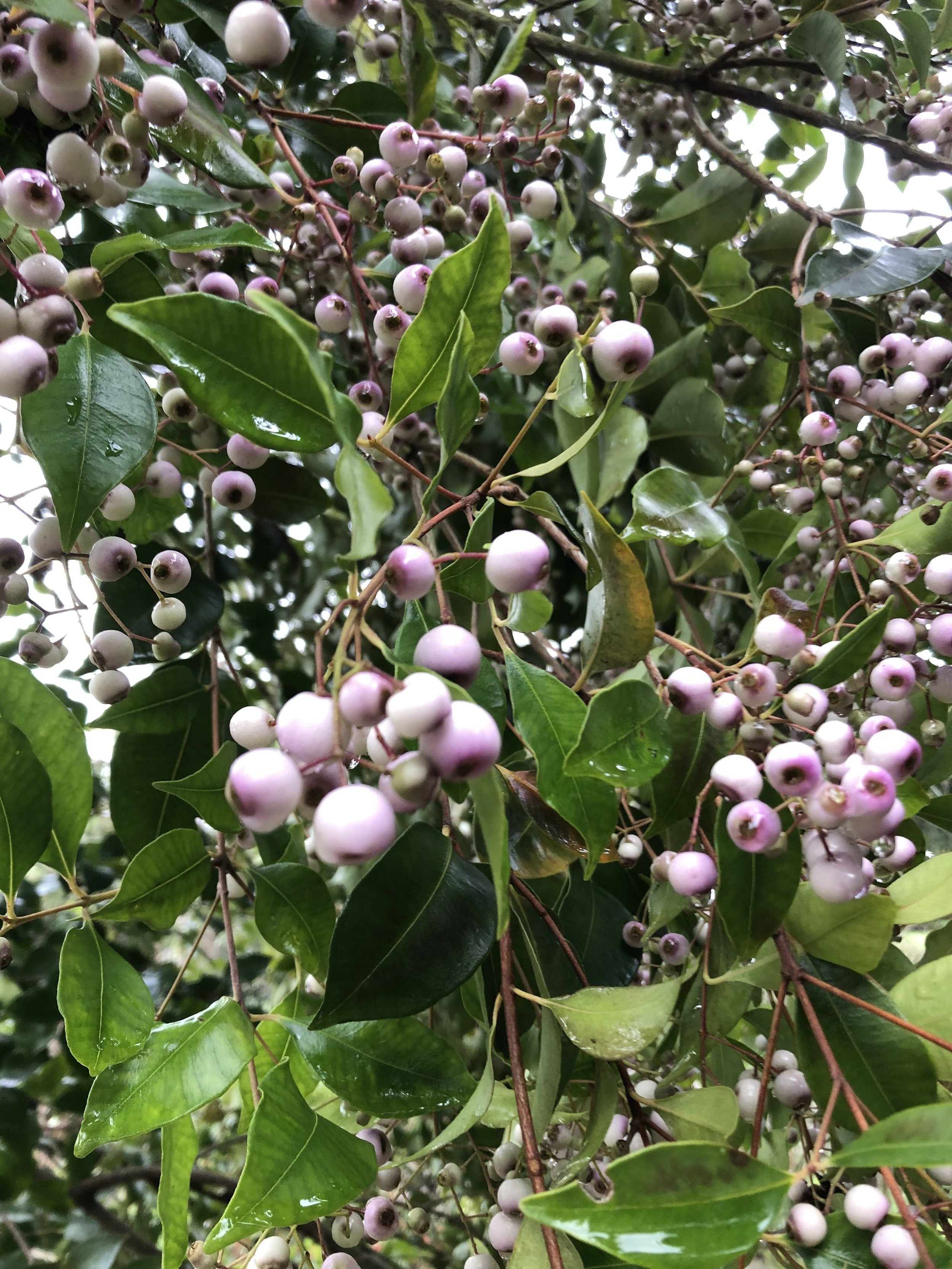Russian Hill #covidtreetour (5-24-20)
[NOTE: our newest tour is of the Castro - chalked on 5/31 - that tour will be up on this site in a day or two!]
This week’s San Francisco #covidtreetour, where we chalk tree descriptions and -> directional arrows -> on sidewalks, to allow social-distancing walkers to safely explore the urban forest, was on Russian Hill. Our group is the same: Jason Dewees (author of Designing with Palms), Richard Turner (Editor Emeritus of Pacific Horticulture), and I’m Mike Sullivan, author of Trees of San Francisco. We saw some great trees today - one of the City’s biggest giant sequoias (see #23 below), and we found a “City Champion” - the largest of its kind in San Francisco (see #42 below).
This tour starts at the venerable Swensen’s Ice Cream Store, at the SW corner of Hyde and Union streets. The walk heads south on Hyde Street to Vallejo Street, then east on Vallejo to Jones Street, north on Jones to Green Street, west on Green to Leavenworth Street, north on Leavenworth to Union Street, a short jog east on Union and back to Leavenworth, continues north on Leavenworth to Filbert Street, west up the steps on Filbert to Hyde, then return south on Hyde to the tour’s beginning at Union Street.
Numbered trees are labeled with common and scientific names and country of origin, all written in white chalk on the sidewalk; accompanying numbers, in blue, run from 1 to 43. White arrows on the pavement provide directions whenever a turn is needed.
Ficus tree (Ficus microcarpa) on Hyde Street next to Swensen’s
The street addresses provided below will help when the chalk has faded. Most of the trees are planted in sidewalk cut; a few are planted on private property between the sidewalk and the house; and some are planted in a mini-park on Hyde and in the quiet residential Havens Street.
Note: Swensen’s is, sadly, closed due to the pandemic. In an emergency, ice cream in containers is available at nearby markets.
Hyde Street, Union to Green, west side
1. 1999 Hyde Ficus tree (Ficus microcarpa ‘Nitida’), India to China
2. 1987 Hyde Cork oak (Quercus suber), Spain & Portugal (4 young trees)
3. 1901 Hyde London plane tree (Platanus x acerifolia), hybrid of E USA species and European species (tree is on Green Street)
Hyde Street, Green to Vallejo, west side
Mediterranean fan palms (Chamaerops humilis), emerging from the fence at 1834 Hyde (there are five more of the palms above the garage to the left)
4. 1834 Hyde Mediterranean fan palms (Chamaerops humilis), western Mediterranean Basin (on left, above stone garage across the street; one is also emerging from the fence to the left of the door)
5. 1834 Hyde Queen palm (Syagrus romanzoffiana), Brazil (tallest palm, above stone garage across the street)
6. 1827 Hyde Fern pine (Afrocarpus gracilior), E Africa (several trees within Hyde & Vallejo Mini-park, on the left of the address). Turn left on Vallejo Street.
Vallejo Street, Hyde to Leavenworth, south side
7. 1255 Vallejo Glossy privet (Ligustrum lucidum), E Asia
8. 1255 Vallejo Southern magnolia (Magnolia grandiflora), SE USA
Vallejo Street, Leavenworth to Jones, south side
9. 1760 Leavenworth Ginkgo (Ginkgo biloba), China (2 trees are on Vallejo side of building)
10. 1187 Vallejo Blackwood acacia (Acacia melanoxylon), SE Australia
11. 1173 Vallejo Kwanzan flowering cherry (Prunus serrulata ‘Kwanzan’), E Asia
12. 1140 Vallejo Marina strawberry tree (Arbutus ‘Marina’), hybrid of Mediterranean species, first discovered in San Francisco (tree is across the street)
13. 1120 Vallejo Brazilian pepper tree (Schinus terebinthifolius), Brazil (tree is across the street)
Jones Street, Vallejo to Green, west side
14. Vallejo & Jones Coast live oak (Quercus agrifolia), California native - and one of the few trees native to San Francisco (tree is above the Jones St wall, opposite 1085 Vallejo at the NE corner of Vallejo & Jones). Turn left on Jones Street.
A row of tulip trees (Liriodendron tulipifera) on Jones Street
15. 1827 Jones Tulip tree (Liriodendron tulipifera), E North America (look up to see the green and orange flowers; tallest hardwood tree in North America)
16. 999 Green Kapuka (Griselinia littoralis), New Zealand (tall hedge on Jones Street side of the high-rise tower)
17. 999 Green Hollywood juniper (Juniperus chinensis ‘Torulosa’), E Asia (SE corner of Green & Jones, next to kapuka hedge). Turn left at Green Street.
view from the corner of Jones and Green
Green Street, Jones to Leavenworth, south side
18. 1025 Green Irish yew (Taxus baccata ‘Fastigiata’), Eurasia & N Africa (2 columnar trees against the house)
19. 1020 Green Evergreen dogwood (Cornus capitata), Himalayas (tree with big white flowers, across the street)
20. 1033 Green New Zealand Christmas tree, pōhutukawa (Metrosideros excelsa), New Zealand
21. 1033 Green King palms (Archontophoenix cunninghamiana), E Australia (2 young palms)
22. 1045 Green Washington thorn (Crataegus phaenopyrum) E USA
Giant sequoia (Sequoidendron giganteum)
23. 1055 Green Giant sequoia (Sequoidendron giganteum), Sierra Nevada, CA native (largest tree species in the world; this tree is one of SF’s best examples)
24 1055 Green English holly (Ilex aquifolium), W Europe & N Africa
25. 1067 Green Lombardy poplar (Populus nigra ‘Italica’), a variety of Eurasian species (row of narrow trees along east side of 1097 Green)
26. 1097 Green Italian buckthorn (Rhamnus alaternus), Mediterranean Basin. Turn right and head downhill on Leavenworth.
Leavenworth Street, Green to Union, east side
27. 1900 Leavenworth Karo (Pittosporum crassifolium), New Zealand
28. 1932 Leavenworth Purple-leaf plum (Prunus cerasifera), Eurasia (formerly SF’s most planted street tree). Cross the street at Union, and turn right (downhill - the tour goes halfway down this block, and then backtracks.
Union Street, Leavenworth to Black Pl, north side
29. 1048 Union Two palms within the front courtyard:
Clara palm (Brahea armata ‘Clara’), Sonora, Mexico (taller palm on the right)
Mexican blue palm (Brahea armata), Baja California (on the left - it’s only visible if you take a couple steps down the stairs)
30. 1048 Union Apricot (Prunus armeniaca), C Asia
31. 1048 Union Fuyu persimmon (Diospyros kaki ‘Fuyu’), Japan
Return to Leavenworth Street, and turn right (downhill)
Leavenworth Street, Union to Filbert, west side
a Canary Island date palm (Phoenix canariensis) at the bottom of Havens Street
32. Havens Street Canary Island date palm (Phoenix canariensis), Canary Islands the palm is visible from the bottom of the steps). Havens Street is the street where Armistead Maupin, author of Tales of the City, lived while writing the book. It’s a dead end street, but it makes a lovely detour if you have extra time (we did not identify any trees on Havens other than the Canary Island palm).
33. 2049 Leavenworth Victorian box (Pittosporum undulatum) E Australia (also the entire block of trees on the opposite side of the street). Cross Filbert Street, turn left and head uphill on Filbert (one of San Francisco’s steepest streets - it’s a workout).
Filbert Street, Leavenworth to Hyde, north side
34. 1100 Filbert Firethorn (Pyracantha), Eurasia
35. 1110 Filbert Japanese maple (Acer palmatum), Korea & Japan
36. 1110 Filbert Flowering plum (Prunus sp.), Eurasia (fruit are ripening now)
37. 1110 Filbert Red-flowering gum (Corymbia ficifolia), SW Australia (corner of the garden)
38. 1126 Filbert Windmill palm (Trachycarpus fortunei), China
Lemon bottlebrush (Callistemon citrinus)
39. 1141 Filbert Monterey cypress (Hesperocyparis macrocarpa), from central California near Carmel (tallest conifer across the street)
40. 1150 Filbert Lemon bottlebrush (Callistemon citrinus), E Australia
41. 1198 Filbert Indian laurel fig (Ficus microcarpa), India to China (also across the street). At the top of Filbert, cross the street and turn left on Hyde.
Hyde Street, Filbert to Union, west side
Carisco (Persea indica)
42. 2051 Hyde Carisco (Persea indica), Madeira, Azores, Canary Islands. A close relative of the avocado tree, this is a rare tree in San Francisco. There are two trees here - I think the taller one is San Francisco’s “City Champion” for this species.
43. 2027 Hyde Brisbane box (Lophostemon confertus), E Australia
This walking tour of Russian Hill’s street trees was organized by Mike Sullivan, author of The Trees of San Francisco (if you like this Russian Hill tour, there are 12 more neighborhood tree tours in Mike’s book), Jason Dewees, horticulturist at Flora Grubb Gardens and author of Designing with Palms; and Richard Turner, retired editor of Pacific Horticulture magazine and editor of Trees of Golden Gate Park. If you’re a tree enthusiast, buy all three books! You can follow Mike (@sftreeguy) and Jason (@loulufan) on Instagram.

